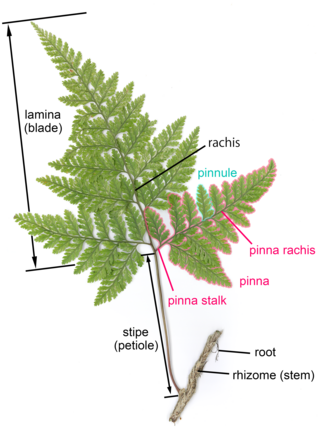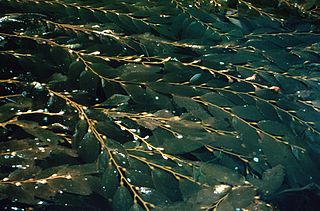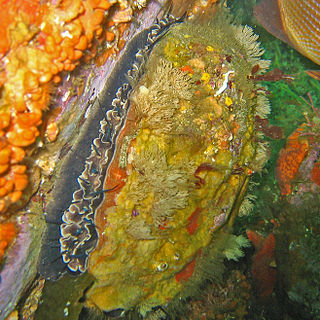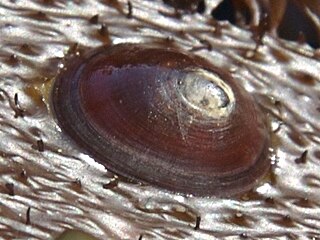
Kelps are large brown algae or seaweeds that make up the order Laminariales. There are about 30 different genera. Despite its appearance, kelp is not a plant but a stramenopile, a group containing many protists.

Brown algae, comprising the class Phaeophyceae, are a large group of multicellular algae, including many seaweeds located in colder waters within the Northern Hemisphere. Brown algae are the major seaweeds of the temperate and polar regions. They are dominant on rocky shores throughout cooler areas of the world. Most brown algae live in marine environments, where they play an important role both as food and as a potential habitat. For instance, Macrocystis, a kelp of the order Laminariales, may reach 60 m (200 ft) in length and forms prominent underwater kelp forests. Kelp forests like these contain a high level of biodiversity. Another example is Sargassum, which creates unique floating mats of seaweed in the tropical waters of the Sargasso Sea that serve as the habitats for many species. Many brown algae, such as members of the order Fucales, commonly grow along rocky seashores. Some members of the class, such as kelps, are used by humans as food.

A frond is a large, divided leaf. In both common usage and botanical nomenclature, the leaves of ferns are referred to as fronds and some botanists restrict the term to this group. Other botanists allow the term frond to also apply to the large leaves of cycads, as well as palms (Arecaceae) and various other flowering plants, such as mimosa or sumac. "Frond" is commonly used to identify a large, compound leaf, but if the term is used botanically to refer to the leaves of ferns and algae it may be applied to smaller and undivided leaves.

Haliotis cracherodii, the black abalone, is a species of large edible sea snail, a marine gastropod mollusk in the family Haliotidae, the abalones.

Lessoniaceae are a family of kelp. Species of this family have transition zone with intercalary meristem subdivided so that there are a number of secondary stipes in addition to the primary stipe.

Fucus is a genus of brown algae found in the intertidal zones of rocky seashores almost throughout the world.

Macrocystis is a monospecific genus of kelp with all species now synonymous with Macrocystis pyrifera. It is commonly known as giant kelp or bladder kelp. This genus contains the largest of all the phaeophyceae or brown algae. Macrocystis has pneumatocysts at the base of its blades. Sporophytes are perennial and the individual may live for up to three years; stipes/fronds within a whole individual undergo senescence, where each frond may persist for approximately 100 days. The genus is found widely in subtropical, temperate, and sub-Antarctic oceans of the Southern Hemisphere and in the northeast Pacific from Baja California to Sitka, Alaska. Macrocystis is often a major component of temperate kelp forests.

Haliotis rufescens is a species of very large edible sea snail in the family Haliotidae, the abalones, ormer shells or paua. It is distributed from British Columbia, Canada, to Baja California, Mexico. It is most common in the southern half of its range.

Durvillaea antarctica, also known as cochayuyo and rimurapa, is a large, robust species of southern bull kelp found on the coasts of Chile, southern New Zealand, and Macquarie Island. D. antarctica, an alga, does not have air bladders, but floats due to a unique honeycomb structure within the alga's blades, which also helps the kelp avoid being damaged by the strong waves.

Erysimum menziesii is a species of Erysimum known by the common name Menzies' wallflower.

Seaweed, or macroalgae, refers to thousands of species of macroscopic, multicellular, marine algae. The term includes some types of Rhodophyta (red), Phaeophyta (brown) and Chlorophyta (green) macroalgae. Seaweed species such as kelps provide essential nursery habitat for fisheries and other marine species and thus protect food sources; other species, such as planktonic algae, play a vital role in capturing carbon, producing at least 50% of Earth's oxygen.

Saccharina latissima is a brown alga, of the family Laminariaceae. It is known by the common names sugar kelp, sea belt, and Devil's apron, and is one of the species known to Japanese cuisine as kombu. It is found in the north Atlantic Ocean, Arctic Ocean and north Pacific Ocean. It is common along the coast of Northern Europe as far south as Galicia Spain, the coast of North America north of Massachusetts and central California, and the coast of Asia south to Korea and Japan.

Discurria insessa, common name the seaweed limpet, is a species of sea snail, a true limpet, a marine gastropod mollusk in the family Lottiidae.

The marine snail Norrisia norrisii is a medium-sized gastropod mollusk within the family Tegulidae. It has several common names, including Norris's top snail, Norris's topsnail, norrissnail, smooth brown turban snail, or kelp snail. It was first described by G.B. Sowerby I under the name Trochiscus norrisii.

Laminaria hyperborea is a species of large brown alga, a kelp in the family Laminariaceae, also known by the common names of tangle and cuvie. It is found in the sublittoral zone of the northern Atlantic Ocean. A variety, Laminaria hyperborea f. cucullata is known from more wave sheltered areas in Scandinavia.

Alaria marginata, the winged kelp, is a brown alga species in the genus Alaria. It can grow up to 13 feet. Fronds are long and narrow with raised midrib and wavy edges. Each frond has two rows of several smooth, oblong, 5 inch spore-bearing blades at the base in winter.
Asplenium × gravesii, commonly known as Graves' spleenwort, is a rare, sterile, hybrid fern, named for Edward Willis Graves (1882–1936). It is formed by the crossing of Bradley's spleenwort (A. bradleyi) with lobed spleenwort (A. pinnatifidum). It is only found where its parent species are both present; in practice, this proves to be a few scattered sites in the Appalachian Mountains, Shawnee Hills, and Ozarks, reaching perhaps its greatest local abundance around Natural Bridge State Resort Park. Like its parents, it prefers to grow in acid soil in the crevices of sandstone cliffs.
Asplenium × kentuckiense, commonly known as Kentucky spleenwort, is a rare, sterile, hybrid fern. It is formed by the crossing of lobed spleenwort (A. pinnatifidum) with ebony spleenwort (A. platyneuron). Found intermittently where the parent species grow together in the eastern United States, it typically grows on sandstone cliffs, but is known from other substrates as well.

Mastocarpus papillatus, sometimes called Turkish washcloth, black tar spot, or grapestone is a species of red algae in the family Phyllophoraceae. It is sometimes confused with the distantly related Turkish towel which is of a similar texture but larger. The specific epithet papillatus is due to the nipple-like projections on the female gametophyte which can give the texture of a terrycloth washcloth found at a Turkish bath.

Chondracanthus exasperatus, commonly called Turkish towel, is a species of seaweed in the family Gigartinaceae. The specific epithet exasperatus refers to the bumpy texture of the blades. This texture also leads to the common name which evokes the luxurious feel of a towel from a Turkish bath. The rough, papillae-strewn blade surface even makes it difficult to measure the temperature using infrared thermometers.






















